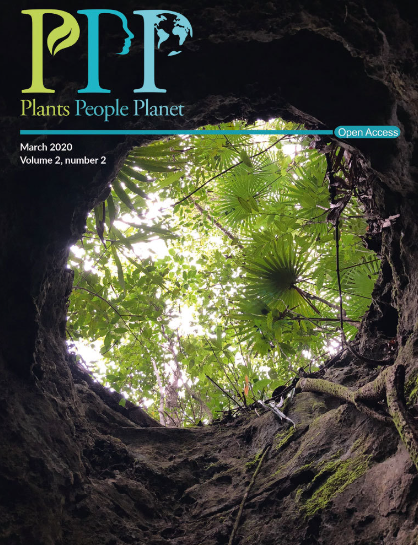白皮松的抗病性及濒危物种恢复的潜力
IF 3.6
2区 环境科学与生态学
Q1 BIODIVERSITY CONSERVATION
引用次数: 0
摘要
世界各地的森林正受到外来、入侵性病原体和害虫的负面影响,一些树种面临着不确定的未来。为了保留这些物种作为未来森林的组成部分,需要确定和利用存在的罕见遗传抗性。白皮松(Pinus albicaulis)是北美西部许多森林中的一种受威胁(在美国)和濒临灭绝(在加拿大)的关键物种,该项目提供了一个例子,说明可以在相对较短的时间内完成什么。电阻的水平和频率因地点而异,这些信息将用于实施国家恢复计划。森林树木面临着来自非本地病虫害的严重威胁,往往造成现有树木和更新树木的高死亡率。发展具有遗传抗性的种群可以帮助恢复森林和保留受影响的物种。从历史上看,抗性项目集中在具有高度经济重要性的物种上;然而,对提供其他重要生态系统服务的直接经济价值不大的物种的威胁也很大。我们研究了北美西部高海拔生态系统的关键物种白皮松(Pinus albicaulis)对白松水疱锈病遗传抗性的频率、水平和地理变异。在这里报道的两项试验中,225棵白皮松母树的2岁幼苗后代接种了两个地理来源的真菌病原体Cronartium ribicola,并在5年内评估了一系列抗性性状。试验主要集中在俄勒冈州和华盛顿州的亲本树上。我们在一些幼苗科和种群中意外地发现了高水平的定量抗性,这与在其他北美白松物种(如monticola Pinus和lambertiana Pinus)中观察到的类似抗性水平形成鲜明对比。在一些白皮松种群中发现的抗性水平为该物种的潜在恢复努力提供了乐观的态度。美国和加拿大的政府机构、部落和非政府组织正在进行修复工作。这些努力可能有助于支持在其他受非本地病原体或害虫严重影响的森林树种中应用遗传抗性项目。本文章由计算机程序翻译,如有差异,请以英文原文为准。
Disease resistance in whitebark pine and potential for restoration of a threatened species
Societal impact statement Forests world‐wide are being negatively affected by non‐native, invasive pathogens and pests, and some tree species face uncertain futures. To retain these species as components of future forests, the rare genetic resistance that exists needs to be identified and harnessed. The applied tree improvement program for whitebark pine ( Pinus albicaulis ), a threatened (in the United States) and endangered (in Canada) keystone species in many forests in western North America, provides an example of what can be accomplished in a relatively short timeframe. The level and frequency of resistance vary by location, and this information will be used to implement the national restoration plan. Summary Forest trees face serious threats from non‐native diseases and pests, often causing high mortality of both the existing trees and regeneration. Developing populations with genetic resistance can help restore forests and retain affected species. Resistance programs have historically focused on species of high economic importance; however, the threats to species of little direct economic value that provide other important ecosystem services are also great. We examined the frequency, level, and geographic variation in genetic resistance to white pine blister rust in the threatened Pinus albicaulis (whitebark pine), a keystone species in high‐elevation ecosystems in western North America. In the two trials reported here, 2‐year‐old seedling progeny of 225 whitebark pine parent trees were inoculated with two geographic sources of the fungal pathogen Cronartium ribicola and evaluated over 5 years for an array of resistance traits. The trials focused primarily on parent trees from the Oregon and Washington populations. We found unexpectedly high levels of quantitative resistance in some seedling families and populations, in stark contrast to levels observed in similar resistance programs with other North American white pine species such as Pinus monticola and Pinus lambertiana . The level of resistance found in some whitebark pine populations provides optimism about potential recovery efforts for this species. Restoration efforts are underway by government agencies, tribes, and non‐government organizations in both the United States and Canada. These efforts may help boost support for applied genetic resistance programs in other forest tree species severely affected by non‐native pathogens or pests.
求助全文
通过发布文献求助,成功后即可免费获取论文全文。
去求助
来源期刊

Plants People Planet
Multiple-
CiteScore
9.90
自引率
5.90%
发文量
81
审稿时长
12 weeks
期刊介绍:
Plants, People, Planet aims to publish outstanding research across the plant sciences, placing it firmly within the context of its wider relevance to people, society and the planet. We encourage scientists to consider carefully the potential impact of their research on people’s daily lives, on society, and on the world in which we live. We welcome submissions from all areas of plant sciences, from ecosystem studies to molecular genetics, and particularly encourage interdisciplinary studies, for instance within the social and medical sciences and chemistry and engineering.
 求助内容:
求助内容: 应助结果提醒方式:
应助结果提醒方式:


